
JANE BURN – POETRY AS HARD GRAFT, INSPIRATION, REACTION OR EXPERIMENT?
I interviewed poet & artist Jane Burn who won the Michael Marks Environmental Poet of the Year 2023-24 with A Thousand Miles from the Sea.
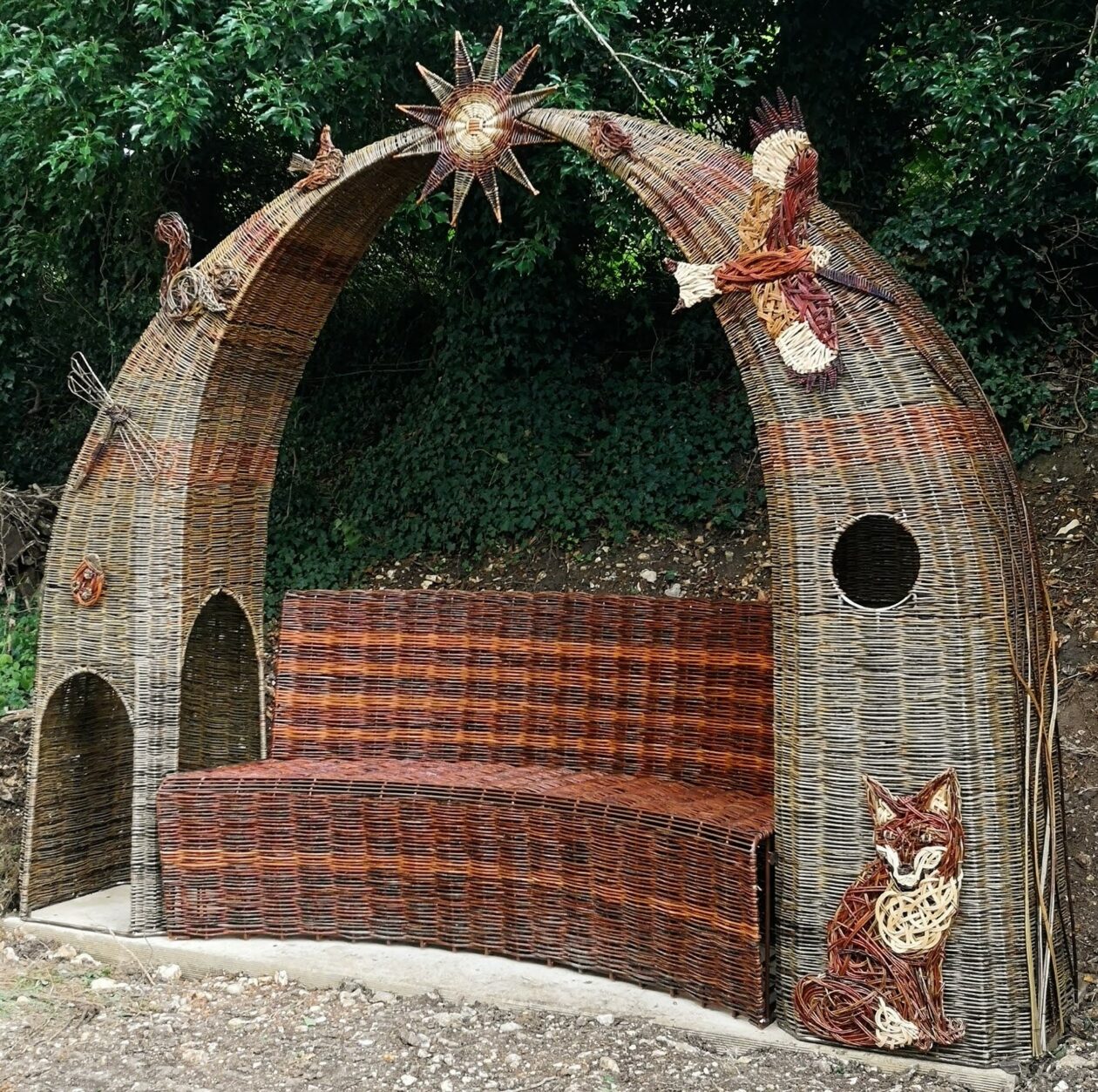

Interview with willow artist Hazel Godfrey, who says about her work: ” I am inspired by nature and love working with natural materials. I grow willow locally in North Herts and this provides for the mainstay of my weaving. I also use other natural materials such as cane, bark, leaves and found items, and have recently added beeswax to my repertoire – an interesting sculptural material to explore.”
Leslie: Looking back, what’s the story of how you came to be a willow artist?
Hazel: As a young adult, I was curious about and attracted to alternative culture and people whose lives felt quite different to my own. For a while I resided on the fringes of a world that introduced me to grassroots arts – musicians, visual artists, poets, and makers. Lacking in confidence, I didn’t think I was interesting enough to belong there, but seeds of possibility had perhaps been sown by the time my disparate group of friends disappeared into their futures. It was many years later that those seeds began to germinate. My children started school and I had time on my hands, so signed onto an introductory art and design course at the local college. At school I hadn’t been ready to learn, but now I certainly was. After the initial course, I completed an Art Foundation diploma specialising in three-dimensional media. I was working with steel and going to be a metal sculptor! I went on to study Applied Arts at university which introduced me to many more materials and techniques, and I really enjoyed designing and working to a brief.
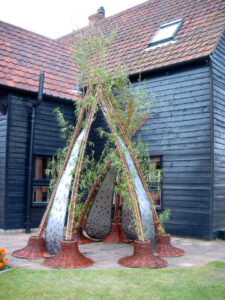
During my final year, a module was delivered by a visiting lecturer, a sculptor working with natural materials who used basketry techniques to construct sculpture. Amongst the available materials to explore were several bundles of willow. I was immediately engaged with the potential of natural materials due to this tutor’s approach to the making of sculpture, and a similarity between willow rods and the steel rods with which I was familiar. I began to combine the two materials in my work, and this culminated in a large steel, willow and copper structure as the final piece of work for my degree. ‘Shooting Steel’ was selected for an important exhibition showcasing the best degree show works in the south east region. I was astonished and the experience allowed me to take the idea of becoming a professional artist seriously.
Leslie: What shaped your interest and your curiosity about nature from an early age?
Hazel: A wonder for nature and respect for learning was shared with me and my siblings from an early age. A strong memory springs to mind of my grandmother gently reaching into a hedge, pulling her arm out and opening her hand to reveal three perfect little speckled blue eggs. She knew about all the hedgerow birds, their nestmaking preferences and the colours of their eggs. Through experiences like this I began to learn that smaller worlds exist within bigger ones and jewels of wonder can be found if you stand quietly, listen, look closely, travel softly.
Looking back, I realise that I was blessed to have been raised within a family of enquiring minds. My Dad had a workshop and was often making or mending. I loved the smell of the workshop: oily, woody, or pungent with unknown chemicals depending on the task. Things happened in there. I learned a love of tools, the worn-smooth handles, and stamped initials of ownership – personal histories of usefulness, self-reliance and respect for hand skills embodied in each and every one.
Leslie: How did you learn to work in this medium?
Hazel: During the making of my final degree work, parts of it required to be traditionally woven and I contacted a basket maker to teach me how to make the shapes I needed.
After this, I joined the newly formed county basketmaking group and learned from other members who worked in willow. I had no formal training, preferring instead to acquire skills on a need-to-know basis according to my interests at the time or techniques required to realise an idea.
Once I reached a certain grounding, it became easier to learn via books and latterly the internet.
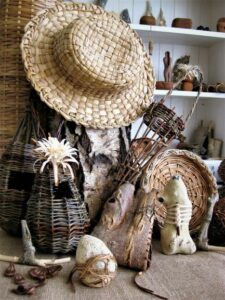
Leslie: How do you grow/obtain willow and the other raw materials that are used in your art? In what ways are they treated to suit your purpose and fit in with the different types of artworks you produce?
Hazel: Willow for weaving is not a difficult crop to cultivate. I grew mine from cuttings planted closely together to encourage the rods to grow straight up without branching. It is coppiced annually during the dormant season between December and early March. When harvesting, the rods are cut leaving a few buds at the base of each stem which begin to grow in the spring. The plants produce rods of different lengths and are sorted by dropping armfuls into a barrel and picking out handfuls of the longest tips each time. After tying into bundles, I store them in a dry place.
I use the willow in many different ways. Dried willow requires soaking in water for several days then mellowing for a day or two before use. I use soaked willow a lot for outdoor structures and baskets. I also use it ‘semi-green’, which is a few weeks after cutting but before it becomes dry and brittle. This helps retain some of the beautiful colours that different varieties yield. I use it to create contrast – it’s great for depicting animals and flowers. I peel the bark from some varieties which gives me useful white stems and lovely strips of bark that are rolled and dried for later use. I make cordage from some of this and weave with it or use as embellishment.
I gather other materials from my garden such as daffodil and montbretia leaves, ivy and clematis stems, fruitwood branches, as well as hedgerow materials and naturally shed bark pieces from the woods. I love picking up interesting natural things when out walking and have quite a large collection of bones, flints and other bits and pieces that inspire me.
Leslie: In what ways are your artworks guided by ‘truth to material’?
Hazel: Truth to material is an interesting theory within the arts but I am not aware of being consciously guided by it. My preference is to work with my materials in a way that celebrates their inherent qualities and possibilities. Many of my larger works are now woven around steel frameworks, but earlier in my career I was more of a purist! The steel method felt ‘untrue’ because it was much more challenging to produce a similar effect using a framework of willow or hazel rods. In reality, the important difference between the two methods is longevity and stability of the work outside. Decay comes as a result of movement in the material – the fibres absorb moisture, swell, then dry out and shrink numerous times over a season. If the structural element of the work is stable, the woven surface moves less, and decay is delayed. This consideration matters to clients.
In terms of truth to materials, every basket made must be an expression of this idea but a simple willow sphere with a random weave surface, made using only natural tension is utter perfection!
Leslie: How did the other techniques you use, such as encaustic wax, first come into the picture, and how do you use them?
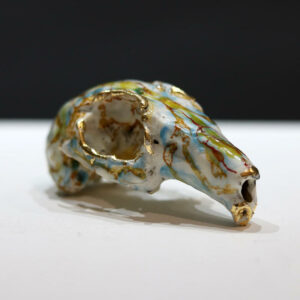
Hazel: This is a new and exciting material to me. I first encountered encaustic wax whilst exhibiting with an artist who was working on a beautiful painting and demonstrating her methods. I was fascinated by the processes and thought beeswax might have potential as a natural material for three-dimensional work. I researched its use and discovered it to be an old medium commonly used in ancient Greek and Roman painting. I felt this resonated well with my use of basketry, an even more ancient technology.
During the first lockdown last year I had time to explore the medium and tried several painting techniques before experimenting with three-dimensional work.
Process is a big part of my attraction to encaustic wax. It is used hot, so I have an electric grill plate with pots of molten pigmented wax and one with neutral wax. Encaustic surfaces are built up in layers, each one being fused to the layer below. This is achieved by applying heat with a gas torch or hot air gun, it prevents layers from flaking off by welding them together. The technique is difficult to transfer to three-dimensional surfaces without melting previous layers off entirely!
I have used the wax to decorate found animal bones and been pleased with the results but it’s very much experimental work at this stage. Ultimately, I hope to find ways of combining encaustic wax with basketry in mixed-media sculptural work.
Leslie: Can you describe how you work, please?
Hazel: It takes me a while to settle into a new project. I start by spending more time than necessary researching aspects of, and possibilities for the work. This activity is part procrastination and part ‘warm-up’ for my thought processes – when I am finally fed-up it’s time to get into the studio. Here the procrastination begins again, and I spend a day or more tidying and re-organising my workspace regardless of need. It is a physical manifestation of clearing my mind, preparing to work, and grounding myself in the space.
If the project is for a client, the next step is to plan and cost it. This is also my drawing stage and the process involves thoroughly thinking through and imagining every step required to achieve the desired outcome. I enjoy it, despite the end anxiety about what I may have missed!
As the time to work approaches, I sort and prepare my willow by soaking it in a tank of water for a week or two. When I am ready to start weaving, I often make a few items that are unrelated but utilise techniques that I will be using for the project, this functions to waken my muscle-memory and increases stock items for later sale. Once project work starts in earnest, I am fully immersed in the physical process of weaving and listening to art podcasts or Radio 4! Willow weaving is a mindful process and this stage, whilst demanding when the work is large, is also enjoyably calm. Watching ideas come to life is as enchanting now as it was in the beginning.
Leslie: What sparks and sustains your creativity?
Hazel: Essentially it is the human condition that sparks and sustains my creativity.
I desire to communicate something about my experience of living that is meaningful on some level to somebody else. Whether it be through the hand-making of a functional object used by another, a sculptural work enjoyed, or through the teaching of skills, it feels important to share with others. Creativity is a universal language, and my life is enriched very much by the conversation.
Leslie: Could you describe the deeper significance of some of your seminal artworks, please? How were they developed?
Hazel: Early in my career, I undertook a 6-month artist residency at a historic walled garden designed in the 1700s. It was undergoing major restoration having become completely dilapidated. The brief was to make work in response to the site at that moment, or to the history of the site, its owners, or staff, using the vast archives made available for research. My interest was in the daily life of a working gardener on the estate. I spent hours that became days and weeks, studying documents and records of what was planted or harvested, methods used, tools used, head gardeners, glasshouse designers, finances – everything except the life of a journeyman gardener was recorded. I was halfway through my time, deflated and in a panic, with nothing to inform my work.
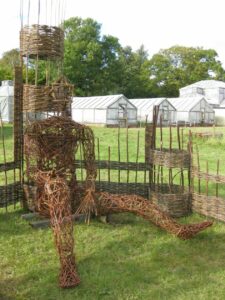
A eureka moment came with the sudden realisation that ‘nothing’ was of course something and my work needed to be about absence. I decided to place this unnoticed person, without whom the grand past garden could not have functioned, into the blank canvas of the present garden. ‘The Ghost Gardeners’ Gazebo’ was realised – an enormous stick folly in which a 12ft willow gardener rested whilst his shelter fell into decay. It resonated with the history of the site in more ways than I could ever have imagined.
The significance of this work for me was understanding that concrete thinking is a limited creative tool for either making or interpreting what might be understood as art. Often it seems a safe place to start, whilst deeper more meaningful thoughts are hopefully formulating somewhere beyond. Perhaps this is what we call ‘creative instinct’, but whatever it is, it requires a bit of patience and sometimes nerve!
Most of my larger works are commissioned so they come with a brief to work within, sometimes this is loose allowing for creative interpretation.
The most recent work I have made is installed at the top of Rectory Lane Cemetery in Berkhamsted. The restoration of the site included new seating for different areas, one of which was the ‘Family Seat’ for a wildlife area at the top of the cemetery. I wanted it to feel playful, promote conversation and learning about nature, and be visually engaging for both children and adults.
In formulating the design, I imagined what might capture a child’s attention and curiosity when approaching the seat, and what might hold on to the sense of discovery and joyful exploration. I think these positive emotions are relevant throughout our lives and a potent symbol of our humanity.
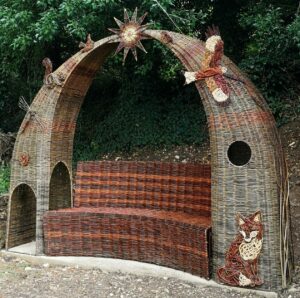
I designed the framework to include interactive elements so children could climb through parts of the structure, experience being enclosed by the weaving, and have fun with peepholes. There is a comfy sofa-style seat situated within a woven gothic arch – a nod to the architectural style of St. Peter’s church. To reflect its location within the more natural area of the cemetery, the arch is adorned with wildlife. There are animals, birds and insects on the front face, and flowers and grasses on the sides, all depicted in different varieties of willow.
I am pleased with the quiet resonance between the Family Seat at the top of the hill and the spirit of discovery that has transformed the cemetery – I hope it feels welcoming after the invigorating walk up through this new and beautiful community space.
Next week I interview Margalit Fox, about her 24-year-career at The New York Times, writing obituaries for Betty Friedan, Maya Angelou, Seamus Heaney, Adrienne Rich, Maurice Sendak, and many more.
ABOUT LESLIE TATE’S BOOKS:

I interviewed poet & artist Jane Burn who won the Michael Marks Environmental Poet of the Year 2023-24 with A Thousand Miles from the Sea.

I interviewed ex-broadcaster and poet Polly Oliver about oral and visual poetry, her compositional methods, and learning the Welsh language. Polly says, “I absolutely love

I interviewed Jo Howell who says about herself: “I’ve been a professional photographic artist since I left Uni in 2009. I am a cyanotype specialist.


Poet Tracey Rhys, writer of Teaching a Bird to Sing and winner of the Poetry Archive’s video competition reviews Ways To Be Equally Human. Tracey,
| Cookie | Duration | Description |
|---|---|---|
| cookielawinfo-checkbox-analytics | 11 months | This cookie is set by GDPR Cookie Consent plugin. The cookie is used to store the user consent for the cookies in the category "Analytics". |
| cookielawinfo-checkbox-functional | 11 months | The cookie is set by GDPR cookie consent to record the user consent for the cookies in the category "Functional". |
| cookielawinfo-checkbox-necessary | 11 months | This cookie is set by GDPR Cookie Consent plugin. The cookies is used to store the user consent for the cookies in the category "Necessary". |
| cookielawinfo-checkbox-others | 11 months | This cookie is set by GDPR Cookie Consent plugin. The cookie is used to store the user consent for the cookies in the category "Other. |
| cookielawinfo-checkbox-performance | 11 months | This cookie is set by GDPR Cookie Consent plugin. The cookie is used to store the user consent for the cookies in the category "Performance". |
| viewed_cookie_policy | 11 months | The cookie is set by the GDPR Cookie Consent plugin and is used to store whether or not user has consented to the use of cookies. It does not store any personal data. |
One Response
Hi Leslie, it really is very interesting to learn about this interesting artwork. Thank you for introducing Hazel and sharing about her journey.